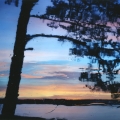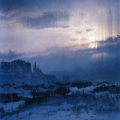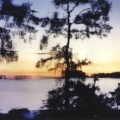Galleri Flach+Thulin has the great pleasure of presenting the work of the Finnish artist Jorma Puranen. The exhibition, comprising the photographic series Icy Prospects, Travels on canvas and the work Where compasses all go mad, opens on Saturday the 4th of October 2008.
The series Icy prospects was born out of the artist’s particular, deep fascination for the arctic and the sense of endlessness, the massive scale and the sense of distance that it evokes. One can also sense a longing to travel and to explore that which is other and that which is elsewhere. The artist was also inspired by observations from Norway’s northernmost point, a place which people from the whole world flock to in order to stare out into the dense fog and further, out across the vast arctic ocean.
The creation of Icy prospects has been in progress since 2002 and new images have been continually added. The series can be regarded as roads – not maps – which follow the contours of a kind of inner mental landscape or geography. The unique quality of the photographs comes from Jorma Puranen’s attempt to create a dialogue between the paintings of the arctic landscape from the early 20th century and his own photographs taken in Lappland and northern Scandinavia, in which light is seen reflected in pieces of black-painted wood.
The series Where compasses all go mad consists of 18 images depicting arctic expeditions, the basis of which come from archive material. This series unites three of the artist’s central areas of interest, the arctic, archival collections, and the use of light and reflections to speak about memories and the past. The series when seen in its entirety, speaks of individual fates and historical time, about the meetings between indigenous populations and polar researchers.
In both of these photographic series, many important themes central to Jorma Puranen’s work are entwined. Here we find clearly identifiable meeting points between the present and the past, between reality and representation, between fact and fantasy. Other thoughts are in evidence; thoughts of marginalisation and diaspora, notions of the picturesque, the mysterious and the unknown.














